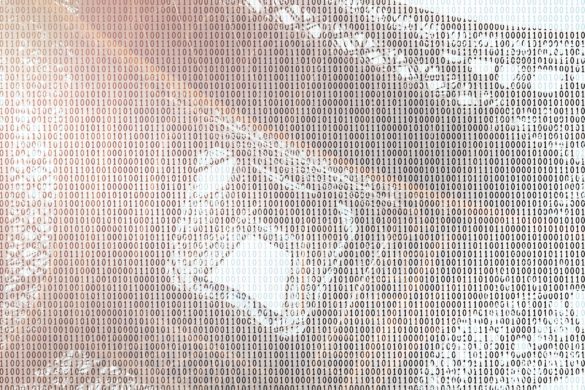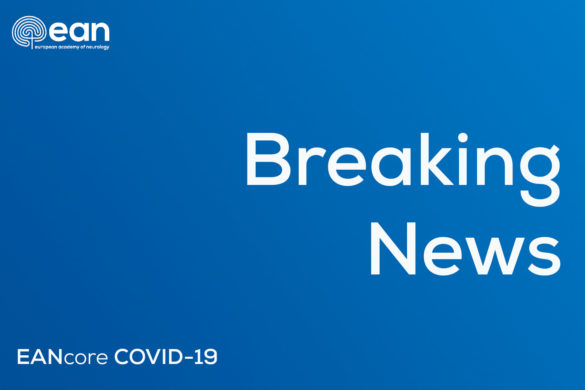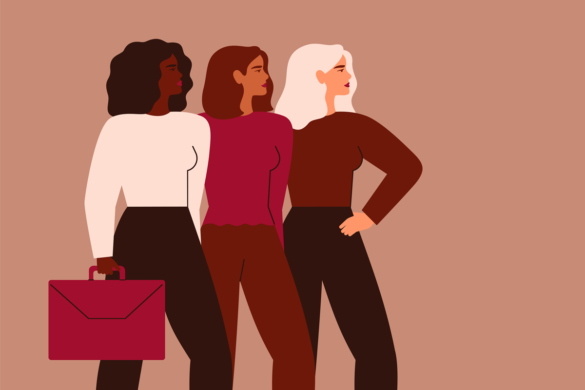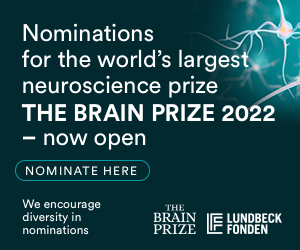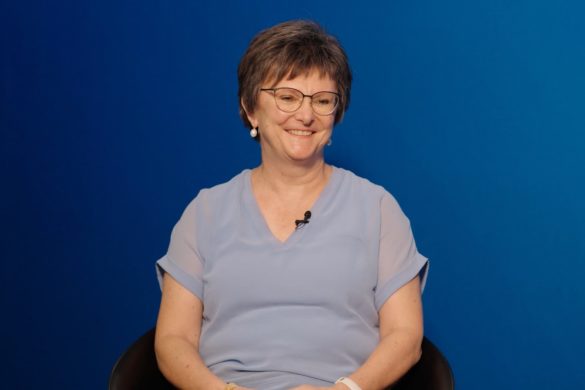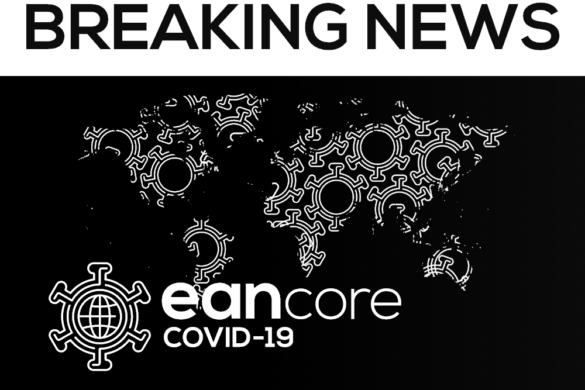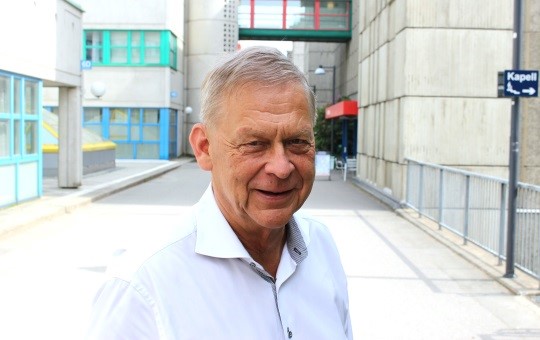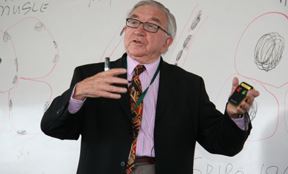
Marianne de Visser (MdV): Neuromuscular diseases are an important topic on our annual congresses, both in the Scientific and in the Educational Program. Therefore we would like to introduce the World Muscle Society of which you are the founding father to the EANpages readership.
Can you please briefly illustrate the WMS and its goals to the readers of the EANpages?
Victor Dubowitz (VD): In March 1995 I met up with Giovanni Nigro and Luciano Merlini in Bologna to discuss the formation of a new international society dedicated to neuromuscular diseases.
I then wrote a personal letter to 60 people active in the field with two questions “Do you think there is a need for an international multidisciplinary Society dedicated to neuromuscular diseases?” and “would you be able to attend an inaugural meeting in London on Sunday 4th June 1995?”
All but 2 were in favour and 15 people from 9 countries including Japan, USA and South Africa and 6 European countries participated in the foundation meeting in London.
(For details see www.worldmusclesociety.org and my review of the first 10 years in Neuromuscul Disord 2005; 15: 642-7). The main objective was to provide a forum for active young researchers to present their current work to a receptive and interactive audience. We set the scene from the first meeting of having a small program committee of officers from WMS and to select 3 active topics for the three days and for most of the presentations to be by poster and only a few updating talks. In one hour one can discuss say 15 poster presentations with a roving chairperson, and two parallel sessions on divergent topics, versus 4 oral platform presentations. We also welcomed advances across the neuromuscular field.
MdV: Does WMS cover all areas of neuromuscular diseases: hereditary and acquired, adults and children? Is ALS which is not always considered to be a neuromuscular disorder covered in WMS congresses?
VD: WMS does indeed cover all neuromuscular diseases including ALS, particularly in relation to the genetic forms but there would obviously be less interest in acquired conditions such as alcoholic or diabetic neuropathies versus the genetic ones. Of prime importance is the quality of the research rather than the specific disease.
MdV: Patients with muscle diseases which are usually rare diseases are managed by several medical specialties, preferably in multidisciplinary teams. How do you see further developments in this field?
VD: I have always promoted multidisciplinary clinics and tried to bring the experts to the muscle clinic to discuss the whole patient rather than dealing just with the isolated organ or system. This made a huge difference to the management of patients with common problems such as scoliosis and respiratory problems rather than being seen in isolation by system specialists often blinkered to the patient beyond the organ. It is also a great stress particularly for the parents of children with Neuromuscular Disorders to be spending a huge amount of time going to multiple different clinics with little intercommunication between them.
MdV: Do you see major changes in the way patients with muscle diseases are going to be managed in the near future? Do you think that the European Reference Centers can facilitate implementation across Europe?
VD: This is a serious problem and I have been very concerned about the disappearance of the clinical doctor who has traditionally been the one to communicate with the patient. I addressed this topic in a symposium organized by the Italian Telethon in 1999 on “Clinical Practice in the 21st Century” with 4 invited speakers who were active research scientists and not clinicians. So I asked the chairperson to allow me a few minutes at the end to make some comments. Too long a story to truncate here, so shall attach a pdf of the commentary in my Ramblings biography. (See below). Research physicians will have to realize that patients with muscle diseases will still need supportive treatment in parallel with all the potential breakthroughs in genetic therapy.
MdV: Members of WMS work together with the European Neuromuscular Centre (ENMC) which organises workshops on a very regular basis. Can you tell the EANpages readers more about this research initiative which is in place for nearly 25 years, who take part in it, how are the workshops organised and what is their aim?
VD: The European Neuromuscular Centre (ENMC) was a great innovation in the early 1990s through the foresight of a number of clinicians and scientists active in the Parent Support Groups in various European countries, such as Giovanni Nigro and Reinhardt Rudel, who saw the need for a forum to promote collaborative research in Europe. Alan Emery as first scientific director was the driving force in the early years and personally read up on the topic of each workshop, presided over it, in addition to the organisers and tried to promote and encourage debate. The principle I followed in several workshops I convened was that there were only participants and no passengers. Thus with the first corticosteroids workshop in 1996 there were only 7 centres in the whole of Europe with experience of it. Similarly with the first of the Therapeutic workshops on Myotonic Dystrophy I was director of from 1997 , I welcomed participants from patient support groups and think the clinicians learnt a lot about what was important to the patients. In recent years the whole character of many workshops has changed with many of the conveners having had no previous experience of the interactive workshops, so they have taken the format of symposia with more formal presentations and minimal debate and discussion and in contrast to the one or two in press references in the early days are more in the format of reviews with large numbers of references. Since the early days they have been regularly published in Neuromuscular Disorders.
MdV: Can you reflect on the future of WMS?
VD: I would like to think the future is very bright but there is always the danger of being destroyed by ones one success. When we started the Society from scratch in 1995 we optimistically set a goal of 500 members by the millennium. We actually made it. We also established a number of important principles from the outset. In the spring of 1996 the Association of British Neurologists met at the Commonwealth Centre where we were to meet in the autumn. So I registered for it and also paid my extra £40 for the dinner at the Science Museum, thinking of it as a possible venue for our dinner. It was an excellent venue and an excellent dinner but to my surprise only 30 members attended! The other I presume were mainly being wined and dined by industry. So I decided that our own dinner would be obligatory for all members and free of charge. And we have continually run at full house. We have also provided free lunches, nd had long lunch breaks to promote social and scientific intercourse and provide extra time for the poster viewing. We have not had any satellite meetings running in parallel with our meeting. When we met in Perth in 2013 there was concern of the local organisers we would not have sufficient participants to break even. So we agreed to two industry-sponsored symposia, which would be part of our meeting and open to all. This worked well but posed an additional problem the next year with 3 symposia and the following year with 4. So we have set a limit of 4 for each meeting and declined any additional sponsors. I have been very happy to see the growth of the Society from birth to full maturity and decided at the last 3-yearly election of the executive board in Granada last year, that I would stand again for the board but would not seek re-election as president. It was definitely time to cut the umbilical cord of the fledgling society. The main problem for the future is to try and control the continued exponential growth of the Society, which could drastically change the selection of suitable out of the way venues, and the whole ambience and character of the meetings.
Prof. Dubowitz I thank you for this very informative interview and wish you and WMS further success.
Marianne de Visser, EAN Liaison Committee




